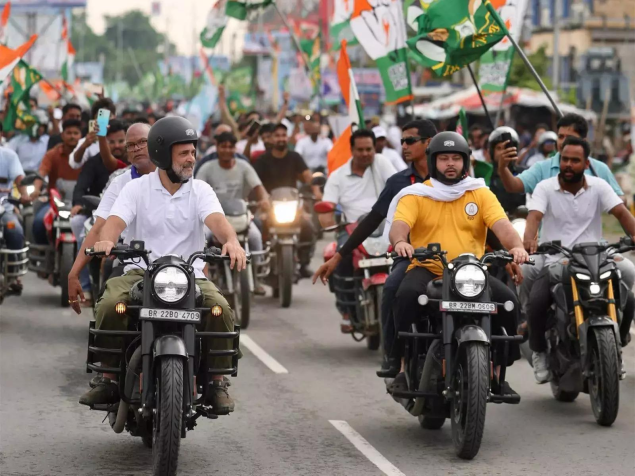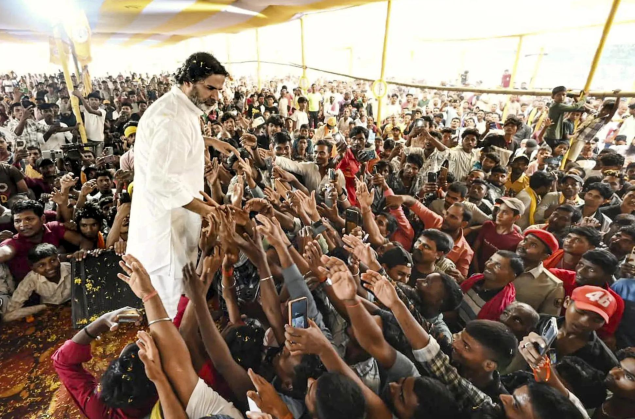In the lead-up to Bihar’s assembly polls, three major marches: Rahul Gandhi’s Voter Adhikar Yatra, Tejashwi Yadav’s Bihar Adhikar Yatra and Prashant Kishor’s Jan Suraaj Padyatra were expected to energise the opposition and reshape the election narrative. All three drew large crowds and garnered a lot of attention.

Yet, when the votes were counted, none of these grand yatras translated into electoral gains. The BJP-led NDA romped home with over 202 seats out of 243, consigning Congress and its allies to a crushing defeat. The INDIA bloc’s ambitious marches proved ineffective: Rahul Gandhi’s Voter Adhikar Yatra did not prove to be a trump card, and its message of “vote theft” remained largely irrelevant in Bihar politics.
Likewise, Tejashwi Yadav’s tour failed to expand his party’s base, and Kishor’s two-year-long trek ended without a single Jan Suraaj victory. In short, symbolism could not substitute for organisation in Bihar’s rugged electoral terrain.
Yatras: A time-honoured tool of Indian politics
Pan-India “padayatra” has long been a favourite strategy for politicians seeking to connect with voters. And they are suddenly all the rage in politics, with leaders across parties taking to the road in dramatic, high-octane treks. Rahul Gandhi helped revive the trend with his Bharat Jodo Yatra in 2022–23, walking nearly 4,000km from Kanyakumari to Srinagar, followed by the far longer Bharat Jodo Nyay Yatra earlier this year. Hot on his heels came Tamil Nadu BJP chief K Annamalai, whose En Mann, En Makkal journey criss-crossed 10,000km and ended with a grand finale attended by the Prime Minister. TDP’s Nara Lokesh completed his own youth-focused Yuva Galam, insisting it was more about listening than winning.Such yatras can energise party cadres and highlight campaign themes. The yatras can be termed as “sanjivani” (life-giving) for parties, refreshing the organisation and giving campaigns a solid foundation.In Bihar, where rural networks and caste ties are crucial, parties often deploy yatras to visit far-flung villages and rural clusters. A well-timed yatra can build momentum by showing unity and giving voters a sense of participation. Yet this year, spectacle without substance was no match for the NDA’s disciplined strategy. Despite the grand fanfare of these three yatras, Bihar’s electorate delivered a very different verdict.
Rahul Gandhi’s Voter Adhikar Yatra
Rahul Gandhi’s Voter Adhikar Yatra (August–September) was hyped as a campaign to protect voter rights. Covering over 1,300 km across 25 districts and more than 100 constituencies, Rahul donned Bihar’s cultural symbols, the gamcha scarf, a cap and attacked alleged “vote chori” (vote stealing) and the state’s Special Intensive Revision of rolls. The march began with impressive crowds, especially in Sasaram, and projected Congress’s return to rural areas.However, from the very start, it was clear that public enthusiasm would not last. In the ensuing weeks, energy fell sharply. The yatra began with strong crowds, but as the campaign moved forward, the initial spark faded. Congress leaned heavily on the yatra’s symbolism but failed to build an effective ground organisation. Outside of a few big rallies, senior Congress leaders were largely absent, and booth-level mobilisation was weak. Rahul’s strategy focused obsessively on national issues like electoral rolls, which did not strike a chord with most Biharis. Ordinary voters were more concerned with jobs, inflation and local governance than allegations of “voter chori.”

Rahul’s campaign squandered precious time attacking the Election Commission, and the shift backfired. After rallying around national narratives, Congress’s messaging was drowned out by local realities it failed to read. By election day, Congress only won 6 seats out of 61 contested: a miserable 10% success rate. Rural crowds did not turn into rural votes. Internal alliance tensions didn’t help either: Rahul kept a distance after the Yatra and reappeared only weeks later, and the absence of sustained leadership further undermined Congress.Meanwhile, Bihar’s ruling BJP and JD(U) gleefully declared Rahul’s march a flop show. Their taunts echoed the ground reality: for all its high production values, the Voter Adhikar Yatra failed to translate into votes for Congress, leaving the party facing one of its worst-ever Bihar results. In short, Rahul’s narrative of “vote chori” and his focus on fighting SIR proved largely irrelevant to the Bihar electorate. His Yatra simply did not prove to be a trump card.
Tejashwi Yadav’s Bihar Adhikar Yatra
Tejashwi Yadav’s Bihar Adhikar Yatra was launched on September 16, almost immediately after Rahul’s tour. Setting out from Jehanabad, Tejashwi promised to challenge the Nitish Kumar government on unemployment, crime and local grievances. The yatra was partly pitched as filling gaps left by Rahul’s march; RJD officials openly said they covered districts left out of the Voter Adhikar Yatra. By highlighting issues in RJD strongholds: Jehanabad, Nalanda, Supaul, Saharsa and others. Tejashwi aimed to consolidate his party’s core vote and signal that the RJD was the main force in the INDIA bloc. He also used the trip to assert himself: earlier, he had declared he would contest all 243 seats, underlining his claim to be the alliance’s undisputed leader.In theory, Tejashwi’s focused effort should have solidified his social coalition and countered anti-incumbency. In practice, it barely made a dent outside his base. By election day, the RJD had outperformed Congress, but only marginally: the party was on course for about 25 seats, far below its 75 in 2020. Tejashwi failed to convert the momentum and anti-incumbency wave against Nitish Kumar into actual votes, leaving the RJD with its second-worst tally ever. The much-heralded yatra vision of reaching every village did little to overcome the RJD’s narrow caste profile. Most communities beyond the Muslim–Yadav base remained unconvinced, and even within the RJD, ticket distribution caused resentment. Seat-sharing disputes led to friendly fights where opposition partners split the anti-NDA vote.In the end, Tejashwi’s personal crusade could not overcome these structural flaws. The RJD held on to pockets of support but did not expand beyond its traditional base. The youth-versus-experience narrative he touted collapsed under the weight of Nitish Kumar’s intact governance credentials and the shadows of the “jungle raj.”
Prashant Kishor’s Jan Suraaj padyatra
Prashant Kishor entered the fray with arguably the grandest walking tour of all: a 3,500 km Jan Suraaj Padyatra launched on Gandhi Jayanti 2023. A celebrated poll strategist-turned-aspirant, Kishor promised a people’s movement – reaching every panchayat, listening to voters, and forging a vision document on education, health and agriculture. For months, he walked through remote Bihar, courting media attention and projecting himself as an alternative to both the NDA and the Grand Alliance.

Yet on November 14, the results laid bare the folly of that endeavour. The Jan Suraaj Party failed to register a single electoral win. Most of its candidates forfeited their deposits, signalling minimal vote share. Kishor entered the Bihar polls as a political aspirant and walked out as its biggest loser. Despite all the media hype, his technocratic, governance-centric message did not resonate in a polarised contest dominated by clear caste and welfare narratives. Voters showed little appetite for this new kind of politics.Kishor had gambled that his nationwide profile and long trek would translate to votes; instead, it highlighted the disconnect. The Jan Suraaj experiment demonstrated that mere visibility cannot replace grassroots machinery. His late decision to withdraw candidates from certain constituencies only reinforced perceptions of organisational chaos.
Structure trumps yatra
While the three opposition yatras floundered, the NDA executed a far more disciplined and targeted campaign. The alliance maintained unity and clear messaging throughout. The BJP ceded certain seats to allies to consolidate OBC and Dalit votes. Caste calculations paid off, and the coalition’s welfare-focused agenda resonated strongly. Record female turnout over 71% tilted the mandate towards the NDA, driven by schemes such as women’s entrepreneurship subsidies.The NDA ran on a combination of Nitish Kumar’s governance brand and BJP’s organisational muscle. Nitish (JD(U)) carried the narrative weight, focusing on law-and-order and welfare. He unleashed a series of high-profile welfare schemes for women, the elderly and the poor: for example, a deposit of Rs 10,000 in women’s accounts, free electricity up to 125 units, and higher pensions

In contrast, the Mahagathbandhan’s strategy was messy. Seat-sharing remained an open wound: even on the eve of polling, allies had not finalised allocations, leading to several cases where partners fielded candidates against each other. This confusion squandered whatever goodwill Rahul’s Yatra had generated. The INDIA bloc lacked a coherent narrative. Issues like the Special Intensive Revision failed to galvanise voters, whereas the NDA’s focus on good governance and economic benefits rang true at the booth level. The opposition entered the polls divided, with disputes and no unified strategy, while the NDA’s welfare-focused messaging proved far stronger.Grand marches can generate excitement, but in Bihar, they cannot substitute for solid organisation and clear leadership. Rahul Gandhi’s 1,300-km yatra dazzled onlookers but saw Congress’s vote share collapse to one of its lowest levels. Tejashwi Yadav’s bid for prominence reinforced the RJD’s base but did not expand it. And Prashant Kishor’s sprawling padyatra proved that even two years of walking cannot conjure an instant vote ban Go to Source


